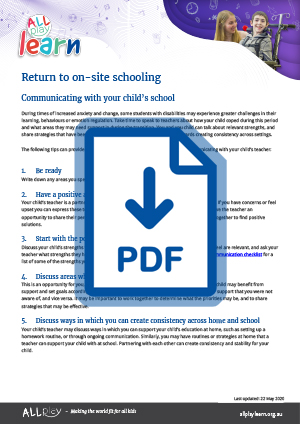
Parent guide to parent-teacher communication
Parent-teacher communication provides an opportunity for you to work together with your child’s teacher. You can partner with your child’s teacher to identify your child’s strengths and areas where support may be needed, share strategies that have been effective at home or school, and identify ways in which you can work together to create consistency across home and school to achieve the student’s goals.
The following tips can provide a prompt or support for you in preparation for meeting with your child’s teacher:
1. Be ready.
Write down any areas you specifically want to talk about beforehand, and bring this list to the meeting.
2. Have a positive attitude.
Your child’s teacher is a partner with you in your child’s learning, development and inclusion. If you have concerns or feel upset you can express these to the teacher in a calm way. Attend the meeting with the intent to give the teacher an opportunity to share their perspective of the situation, and with the view that you can work together to find positive solutions.
3. Start with the positive.
Discuss your child’s strengths first. Share with the teacher any strengths you feel are relevant, and ask your teacher what strengths they have identified. Access AllPlay Learn’s strengths and abilities communication checklist for a list of some of the strengths your child may have.
4. Discuss areas where support may be needed.
This is an opportunity for you and your child’s teacher to share areas where your child could benefit from support and set goals accordingly. Your child’s teacher may have identified opportunities for support that you were not aware of, and vice versa. It may be important to work together to determine what the priorities may be, and to share strategies that may be effective. Strategies that draw on your child’s strengths may be most effective. Access AllPlay Learn’s strengths and abilities communication checklist for a list of some of the areas of support you may wish to discuss.
5. Discuss ways in which you can create consistency across home and school.
Your child’s teacher may discuss ways in which you can support your child’s education at home, such as setting up a homework routine, or through ongoing communication. Similarly, you may have routines or strategies that your child uses at home that your teacher can support your child with at school. Partnering with each other can create consistency and stability for your child.

